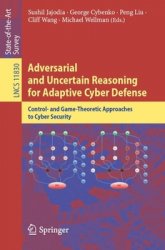 Название: Adversarial and Uncertain Reasoning for Adaptive Cyber Defense: Control- and Game-Theoretic Approaches to Cyber Security
Название: Adversarial and Uncertain Reasoning for Adaptive Cyber Defense: Control- and Game-Theoretic Approaches to Cyber Security Автор: Sushil Jajodia, George Cybenko, Peng Liu
Издательство: Springer
Год: 2019
Страниц: 270
Язык: английский
Формат: pdf (true)
Размер: 15.7 MB
Today’s cyber defenses are largely static allowing adversaries to pre-plan their attacks. In response to this situation, researchers have started to investigate various methods that make networked information systems less homogeneous and less predictable by engineering systems that have homogeneous functionalities but randomized manifestations.
The 10 papers included in this State-of-the Art Survey present recent advances made by a large team of researchers working on the same US Department of Defense Multidisciplinary University Research Initiative (MURI) project during 2013-2019. This project has developed a new class of technologies called Adaptive Cyber Defense (ACD) by building on two active but heretofore separate research areas: Adaptation Techniques (AT) and Adversarial Reasoning (AR). AT methods introduce diversity and uncertainty into networks, applications, and hosts. AR combines machine learning, behavioral science, operations research, control theory, and game theory to address the goal of computing effective strategies in dynamic, adversarial environments.
In this book, we leverage reinforcement learning as a unified framework to design effective adaptive cyber defenses against zero-day attacks. Reinforcement learning is an integration of control theory and machine learning. A salient feature of reinforcement learning is that it does not require the defender to know critical information of zero-day attacks (e.g., their attack targets, and the locations of the vulnerabilities). This information is difficult, if not impossible, for the defender to gather in advance. The reinforcement learning based schemes are applied to defeat three classes of attacks: strategic attacks where the interactions between an attacker and a defender are modeled as a non-cooperative game; non-strategic random attacks where the attacker chooses its actions by following a predetermined probability distribution; and attacks depicted by Bayesian attack graphs where the attacker exploits combinations of multiple known or zero-day vulnerabilities to compromise machines in a network.
We formulate cyber security problems with many strategic attackers and defenders as stochastic dynamic games with asymmetric information. We discuss solution approaches to stochastic dynamic games with asymmetric information and identify the difficulties/challenges associated with these approaches. We present a solution methodology for stochastic dynamic games with asymmetric information that resolves some of these difficulties. Our main results are based on certain key assumptions about the game model. Therefore, our methodology can solve only specific classes of cyber security problems. We identify classes of cyber security problems that our methodology cannot solve and connect these problems to open problems in game theory.
Contents:
Скачать Adversarial and Uncertain Reasoning for Adaptive Cyber Defense: Control- and Game-Theoretic Approaches to Cyber Security
